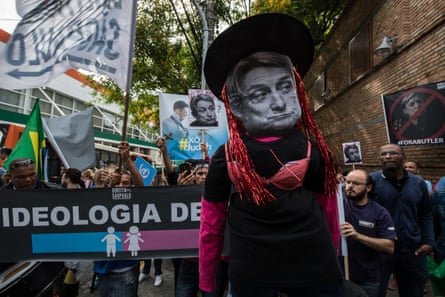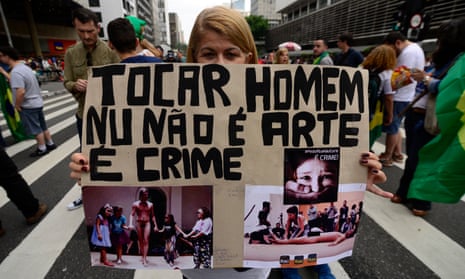On a recent afternoon, art lovers leaving a sexually explicit exhibition at the São Paulo Museum of Art (MASP) were met by a group of bearded men in glittery makeup and tutus dancing to deafening electronic music at the head of a march against censorship and homophobic violence.
As the demonstrators made down their way down the city’s Paulista Avenue, they passed a group of evangelical Christians, who waited impassively for the noise to abate before joining hands to pray and sing religious rock songs.
Despite its libidinous carnival, sexy music and skimpy clothes, Brazil is also a deeply conservative and religious country – and it is currently witnessing a culture war between those two sides of its national character.
The battlefield for those skirmishes has been the country’s museums and cultural institutions. In September, a deluge of online protests and small yet vocally aggressive pickets by evangelical Christians and rightwingers scared the multinational Santander bank into closing an uncompromising gay art exhibition called Queer Museum in Porto Alegre. They accused it of promoting paedophilia, blasphemy and bestiality – charges its curator, Gaudêncio Fidélis, vigorously denied.
Weeks later, similar protests were directed at São Paulo’s prestigious Museum of Modern Art, the MAM, after a child was filmed touching the finger, ankle and foot of performance artist Wagner Schwartz as he lay naked during a work called La Bête during a contemporary art show opening. This time the publicly run museum held firm, but the noise did not die down. Both curators were later summoned to an inquiry in the Brazilian senate.
The fierceness of the protests prompted the MASP to take legal advice before even opening its current (and long-planned) exhibition Histories of Sexuality.
“Censorship is a form of repression,” said Alessandra Almeida, 43, a political scientist who joined the anti-censorship parade outside MASP last Saturday. “This radical, moralist, Christian right gained strength in congress and the left did not pay attention.”

Inside, Histories of Sexuality included a naked woman in Pablo Picasso’s La Toilette, Betty Tompkins’ self-explanatory Pussy Paintings and Marcelo Krasilcic’s 1969 photo series Daniel and the Boys of Arouche St, which depicts a penis at a car window besides the smiling face of a young man.
For its first two weeks only over-18s were admitted. Then, following an interpretation of Brazilian laws published by federal prosecutors, the museum changed policy to allow minors in with their parents.
“We feel that the more people who can access the exhibition, the better,” said Adriano Pedrosa, artistic director of the MASP. “You might not be interested in a certain exhibition or agree with it – but that does not mean it cannot open.”
Late on Saturday afternoon, the only children at the gallery were Joaquim, 8, and Miguel, 7, who were led around by their mother Milena Messias, 44, an agricultural engineer. The boys paid little attention to the works and seemed keen to leave.
“[Sex] is what happens with humanity, it is part of us,” said Messias, adding that she wanted to show her sons how “famous artists use the nude figure as part of their work”.

Other visitors also praised the show. “Our advertising is very sexist,” said Rafaela Freitas, 18, a student from Salvador in the north-east of Brazil. “[But the exhibition] does not treat women as a piece of meat. It shows sexuality in a more natural way.”
Many of Brazil’s growing number of evangelical Christians would disagree. Their numbers have increased from 9% of the population in 1991 to almost a quarter today.
Marco Feliciano, an evangelical pastor and lawmaker from São Paulo state, said children should not be allowed into explicit exhibitions and argued that some of the works in the Queer Museum exhibition were blasphemous: for example, Last Resort by Felipe Scandelari, which shows the Virgin Mary cradling a monkey like a baby.
“Art is there to mess with my soul, to show me what is beautiful, to show me what is fantastic,” Feliciano said, saying he liked Da Vinci and Botticelli but hated Jackson Pollock. “This modern art today is very weird.”
But Brazil’s current culture wars have also thrown together some curious allies: evangelical campaigners have found common cause with the Free Brazil Movement (MBL), a libertarian group who helped organise anti-corruption protests that drove the impeachment of leftwing president Dilma Rousseff last year.

Other figures who have joined Brazil’s aspiring “moral majority” include Alexandre Frota, a minor celebrity and rightwing activist with 41,000 Twitter followers, who previously worked as an actor in pornographic movies including Sex, Sweat and Samba and Total Anal 10.
He objected to works such as the 1994 painting Cena de Interior II (Interior Scene II) by Brazilian artist Adriana Varejão in Queer Museum for its scenes of group sex and bestiality. A YouTube video of him and other protestors at the MAM has been watched over 200,000 times.
But he said that did not mean he was against art, or even nudes.
“You can’t compare Michangelo’s David to a child touching a nude man or a painting with a clear group-sex connotation and even bestiality,” he said. “When I went to the MAM, I went as an act of repudiation to the ideology of debauchery hidden as art. I don’t accept this.”

Frota said he saw no contradiction in a former pornographic actor attacking contemporary art for being too explicit. “All my films were for adults,” he said. “I don’t deny my past nor am I ashamed of it.”
Many conservatives and evangelical Christians also target what they call “gender ideology”, which they describe as the idea that gender is a cultural construction rather than a sacred biological reality.
Earlier this month, more than 300,000 people signed an online petition in an attempt to bar the US academic Judith Butler, a leading voice in gender studies, from attending a conference at São Paulo’s SESC Pompeia cultural centre. Hundreds demonstrated in her favour and against outside – one group even carried an effigy showing her as a witch in a pink bra.
“The group who engaged this frenzy of effigy-burning, stalking and harassment want to defend ‘Brazil’ as a place where LGBTQ people are not welcome, where the family remains heterosexual (so no gay marriage), where abortion is illegal and reproductive freedom does not exist,” Butler said in an interview for the Inside Higher Education site.

For Felipe Chaimovich, curator of the MAM, the warfare is not about language, but something much deeper.
“This is much more serious than a word,” he said. “These are conservative groups with intolerant tendencies, who use a moralistic, prejudiced message to mobilise an increasingly massed and unthinking response.”
He and Fidelis, the curator of the Queer Museum exhibition, were called to testify before a congress inquiry into crimes and irregularities against children and teenagers presided over by Magno Malta, an evangelical pastor and senator.
Despite this, Fidelis said he has been energised by the the episode, and argued that the controversy and triggered a debate that Brazil could only benefit from.
“I think we are winning this battle. I think that society is very mobilised against these protests,” he said.
Brazilian health professionals have debated the issue. “The theme is delicate, because it touches on society’s current fears, which are abuse, childhood eroticisation, paedophilia,” Daniel Martins de Barros, a psychiatrist at the Clinícas hospital run by the University of São Paulo, wrote in the Estado de S Paulo newspaper.
“I don’t know any scientific evidence, no published work, showing that this would be bad for a child, or that it would not be,” he said, though he added that he would not encourage taking a child to such a show. “Given the doubt, I would prefer not to risk it.”
Chaimovich said that there was nothing erotic nor sexual about Schwartz’s La La Bête performance. He pointed to a sign painted on a wall stating: “This exhibition contains nudity.”The curator compared Brazil’s cultural warfare to the rise of fascism in prewar Europe, noting that 80 years ago, in 1937, Nazi Germany held the Degenerate Art exhibition, which featured contemporary works by artists like Paul Klee alongside graffiti ridiculing them.
“Identifying modern art with the enemy is classic European fascism,” Chaimovich said. “What is in play is the right to expression.”
Guardian Cities is in São Paulo for a special series of in-depth reporting and live events. Share your experiences of the city in the comments below, on Facebook, Twitter and Instagram using #GuardianSaoPaulo, or by email to saopaulo.week@theguardian.com

Comments (…)
Sign in or create your Guardian account to join the discussion